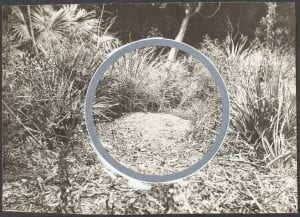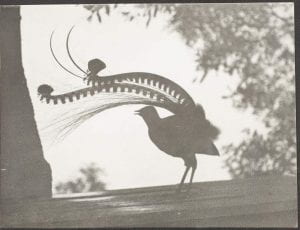The Mimic of the Bush: The Australian Lyrebird in its Natural Habitat
Sylvie Kitanova-Hume is a PhD candidate at the University of Melbourne’s School of Languages and Linguistics. Her thesis examines western feature film imports in the German Democratic Republic in the 1970s.
Let us spend one day as deliberately as Nature, and not be thrown off the track by every nutshell and mosquito’s wing that falls on the rails… –Henry David Thoreau
The inclusion of photographs of nature within the collection of the Commercial Travellers’ Association of Australia develops a visual diary of the remarkable Australian land- and seascape.
12 documentary photographs exhibit the natural habitat of the Australian lyrebird and illustrate a unique, if random, composition of perspectives on its biotope. By creating a dynamic photographic space of delicate artistic balance, some including natural spots, such as tangled undergrowth, fern and moss, mound, tree trunks and nests, the photographs show the beauty of the female and male lyrebird.

These black and white photographs were taken between 1923-1949 and were affiliated to a previous group (accompanied by a previous control number) within the CTA collection, titled Australia Today, general fauna and flora 1932-1945. It is interesting to note that a couple of images show a discrepancy between the date they were taken and the collection period they were previously assigned to. (Image 1 & 2)

As one of Australia’s best-known native birds, Menura novaehollandiae and Menura alberti[1] (commonly known as the superb lyrebird and Albert’s lyrebird) can be found in rainforests, bushland and national parks around Victoria, New South Wales, South-East Queensland, and in some parts of Tasmania. Since the location of the photographs is less well documented, this information can roughly specify their geolocation in origin. In addition, lyrebirds are considered shy and difficult to approach, which indicates that the photographs may have been taken with a wide-angle lens. Also, considering the fact that lyrebirds dwell in rather moist forests, where sunlight does not easily penetrate, the quality and luminosity of the photographs is very good. As if sharing a moment in time, the silhouette perspective captures the lyrebird in an artistic way, compared to the more illustrative bush photographs. Digitisation of the otherwise sharply focused black and white photographs leaves however a soft touch.

Seven images were taken on the same date in Sherbrooke Forest, according to the image description, as the best place to observe lyrebirds under natural conditions. (Image 3) Famous for their natural sound imitation, the lyrebirds’ song consists of about 80% impressive mimicry. It is known that they use mimicry to communicate about their territory or attract other birds, but there are also many tales about lyrebirds mimicking barking dogs, chainsaws and ring tones, even copying the sound of trains and humans. Possibly trying to capture the acoustic scope of the lyrebird’s song, a photograph without location details was taken at a clearing, also called mound, a typical place to spot a lyrebird. (Image 4) There, a hidden microphone was intentionally used to record a sound sample of the bird’s song. According to the photographic description, “the nearest human was quarter of a mile away during the recording”[2] later heard in England. The narrative of the microphone uncovers the human ‘absence’ and intervention in the photograph, its distant recording and transmission, hence this poignant image confirms the constructed artificiality of the apparently natural image. The imaginative and materialist geography of this habitual space indicates that although displaying the bushland image of Australian flora and fauna, the photographs were meant for advertising and corporate publicity to a world far away from this reclusive nature.

The mimic of the bush is an emblematic part of Australia’s natural history and culture: it not only features on the reverse of the Australian 10-cent coin and appears in the transparent window of the Australian 100-dollar note, but it also has graced postage stamps and logos of many Australian institutions. Exploring and understanding the CTA collection contributes to a profounder cultural knowledge of the picturesque landscapes of the Australian flora and fauna, which during this period, was invigorated by significant social and cultural changes. Instead of individual photographs, however the viewer of the lyrebird images begins to perceive a structure of meanings which corresponds with the aesthetic perception of travelling into nature.
[1]Birdlife Australia, http://www.birdlife.org.au/bird-profile/superb-lyrebird. Accessed 15 September 2020.; Department of Environment and Science. Retrieved from https://environment.des.qld.gov.au/wildlife/threatened-species/near-threatened/alberts-lyrebird. Accessed 15 September 2020.
[2]“The Commercial Travellers Association.” University of Melbourne, http://gallery.its.unimelb.edu.au/umblumaic/imu.php?request=display&port=45208&id=5b7a&flag=start&offset=0&count=1&view=details&EADUnitID=1979.0162.03039. Accessed 15 September 2020.
Leave a Reply